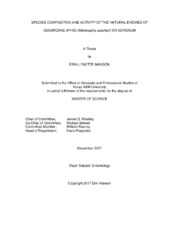| dc.description.abstract | The sugarcane aphid (Melanaphis sacchari) is an emergent sorghum pest in the southern United States. The objectives of this study were to identify the natural enemy species that are feeding on the aphid in grain sorghum in Texas, track seasonal changes in aphid and natural enemy populations across sorghum hybrids that have differing levels of susceptibility to the aphid, and measure aphid suppression by natural enemies of different size classes. Aphids and natural enemies were sampled on multiple sorghum hybrids at two field locations in south and central Texas over two years. Additionally, aphid suppression by natural enemies of two size classes was evaluated using exclusion cages.
Aphids and natural enemies in both locations showed a trend of greater peak abundance on relatively more aphid-susceptible hybrids. At least 19 natural enemy species were present, consisting of parasitoids (Aphelinus sp. and Lysiphlebus testaceipes), lady beetles (Coccinellidae), hoverflies (Syrphidae), lacewings (Chrysopidae and Hemerobiidae), and minute pirate bugs (Anthocoridae). Aphelinus was heavily hyperparasitized by Syrphophagus aphidivorus. Aphelinus and Coccinellidae, the numerically dominant taxa, maintained high activity on resistant sorghum for a longer period than on susceptible sorghum. Natural enemy densities were similarly proportionate to aphid densities on both aphid-susceptible and aphid-resistant plants.
In the cage experiment, small lady beetles (Coccinellidae: Scymninae) were the only natural enemies to differ significantly in density between treatments. Scymninae density and Scymninae per aphid were greatest in closed standard mesh cages. Scymninae density was greater on closed and open standard mesh than on fine mesh. Scymninae per aphid was higher on the resistant x susceptible hybrid. However, aphid density did not differ between cages or hybrids; therefore, aphid suppression was not detected. Problems and potential solutions involving cage integrity are discussed.
Overall, the existing community of aphidophagous insects in Texas has responded rapidly to the sugarcane aphid’s introduction. Continuity in species composition and population trends across both counties and years indicates that the observed response is not an isolated event. The natural enemy complex was observed on both susceptible and resistant hybrids, suggesting that local natural enemies of the sugarcane aphid can complement host plant resistance. | en |


